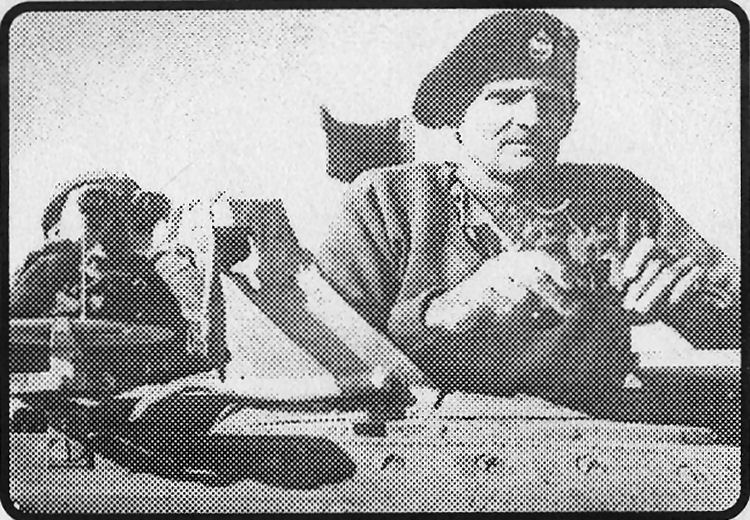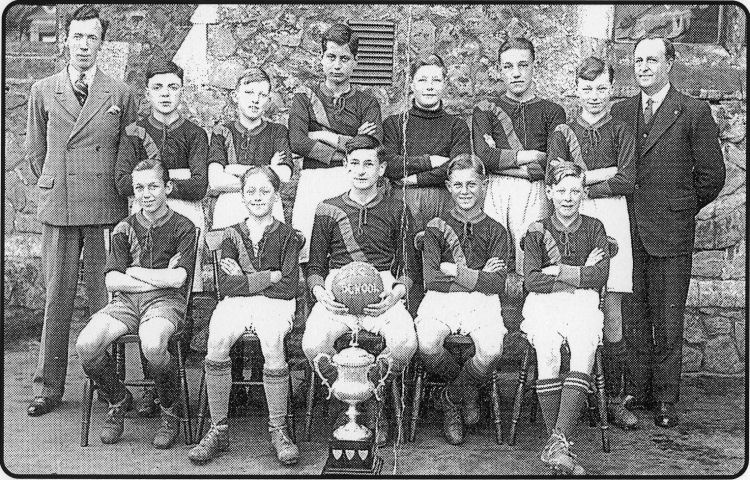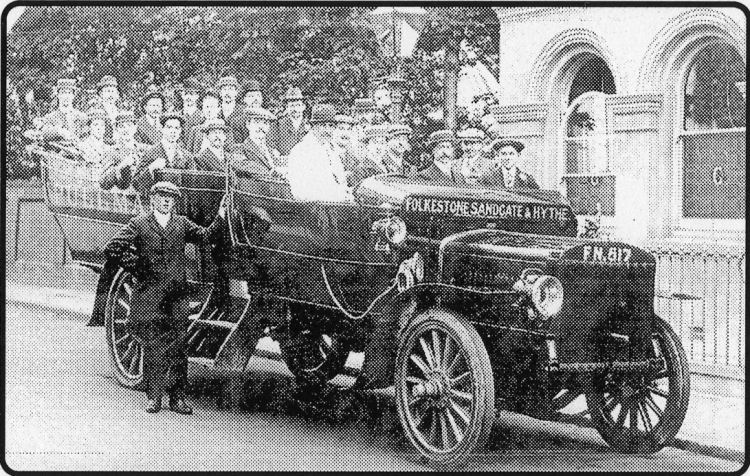
From the Folkestone Herald Published 20 April 2000

REMEMBER the Astoria Cinema picture in Memories recently and the story of
Monty's secret talks during the War?
The cinema opening holds special memories for one reader - see story
below.
Man from Pru.
SURVIVOR of the sinking by the Japanese of the British warship HMS Prince
of Wales in the Far East, in December 1941, Don Clarke sent in the fine
school picture, right of the Chadwick Cup winning team of St Mary’s School
for which he played in 1933.

DON CLARKE, of Cheriton Road, Folkestone thought Memories readers might
be interested to see this fine picture taken some 67 years ago of St Mary’s
School, Folkestone, football team which won the Chadwick Cup in 1933. In the
picture are sportsmaster Mr Williams, headmaster Mr Whewell and the team Is,
left to right, back: H Wimbush, R Clark, J Bull, G Whitehead, P Walters, H
Hall; front, R Ovenden, W Hewson, W Paine, J Hook and D Clarke.
Don, who lives in Cheriton Road, and will be 80 in June is known to many
local residents as ‘the man from the Pru' having worked as an agent for 30
years before he retired.
He left school at 14 in 1934 and served seven years in the Royal Navy.
His ship, the Prince of Wales was returning to Singapore after an
abortive bid to engage the Japanese navy the day after Pearl Harbour when
she was attacked by a huge force of enemy planes and was hit by no fewer
than 15 torpedoes, he told me.
But he was picked up and sent to Ceylon and next joined HMS Capetown,
serving in the Persian Gulf for 15 months.
“And boy, was it hot - 130 degrees in the shade,” he commented. Next he
served on the aircraft carrier HMS Furious, until demob in 1946.
“And what a contrast that was. We were on the Russian run and involved in
attacks on German warships such as the Tirpitz which was sunk.
Don and his wife Barbara, who celebrate their Golden Wedding in July,
have one son, Martin, who is 40 and works in Ashford.
Astoria.
I also heard recently from Harry Storey, of Lyminge, who tells me his
father, Bert, 92, worked for Otto Marx and later his son, for many years and
remembered the building of the old Astoria Cinema.
Bert lived for years in Greenfield Road but has recently been in a
nursing home and recovering after a fall in which he broke a hip.
The family has good reason to remember the Astoria opening - Harry’s
sister Renee now Mrs Barrass, of Hollands Avenue, was born that year. Not
that it stopped Bert using his two free tickets which were given to all Otto
Marx staff on the big project.
During the last war he was a retained worker who was engaged on repairs
and building work in connection with gun sites.
And he had a narrow escape.
He had been in a pillbox in the Leas area Just before it suffered a
direct hit in a bombing or shelling attack and a number of people who were
inside were killed.
Next I have an appeal by transport enthusiast Mr P Hotchin who is hoping
a Memories reader may be able to identify where the Pullman charabanc
picture on this page was taken.
It is a picture I featured in our Wheels motoring section back in 1994.
It probably dates from between the wars and I believe Eric Wills himself, Is
the driver, while the smartly dressed young man behind him may have been his
son Bert.
The only clues to location are the building to the right and the
decorated glass in the windows with the initial ‘G’ in them. Could that
stand for Grand, as in Grand Hotel, I wonder?

THIS old Folkestone charabanc picture was one of a fleet of cars run by
‘Father’ or ‘Pop’ Wills, of Cheriton before he sold out to the East Kent bus
company, but where was it photographed?
 |
|
1900
Easter race meeting-cancellation bombshell.
PROPOSED Easter race meeting at Folkestone race course had been
abandoned and It was stated there would be no racing until August, The
largest number of wounded ever to come back to England from the Boer War
in South Africa In one group, has arrived at Woolwich. There were 337
sick and wounded, 84 with gunshot wounds and others with various forms
of Illness. Personal experiences of the fighting came from Bandsman A.
Smith, of the Northumberland Fusiliers, who told his Dover parents in a
letter how his unit ambushed a force of 600 Boers as they left their
position to get water, claiming 100 dead and 20 prisoners. The
Folkestone Express delivered an outspoken attack on the Town Council, it
said the council had made a hash of building artisans' dwellings, there
were costly public baths, and every month the extravagance of the
sanatorium prompted hostile comment; three subjects on which councillors
had not displayed “conspicuous ability.” And now that £100,000 had been
spent on sewerage It appeared necessary to completely reorganise it! The
latest mistake was to reject the private tramway scheme.
|
|
1925
Bond of friendship forged with cash aid for France.
SOUTHERN Railway issued a statement about postwar
re-construction of the railway system and announced that in 1925 more
than £10 million was due to be spent on rolling stock, engines and
station improvements and the greatest ever scheme of electrification was
to be attempted. Another bond of friendship with France was forged when
Folkestone gave about £860 towards the cost of new waterworks at Morlan-court,
about 20 miles from Amiens. This suffered greatly In the First World
War, nearly every building being destroyed along with farms. Suitable
plaques were unveiled at two reservoirs and a deputation from Folkestone
attended the opening ceremony. At Sandgate where Miss Waddell, the first
woman councillor, attended her first meeting, receiving a warm welcome,
the council was told of the latest meeting with bus owners over regular
services. The firms had been formed into two groups to run a two
minutes’ service. One councillor said Ideally there ought be Inspectors
to monitor the service. Major Newman said Folkestone Council would not
approve specified stops which meant buses could pick up where they liked
which was not ideal, it was reported that a joint meeting was to be held
with Hythe over a plan for a water supply from Peraker Wood.
|
|
1950
Channel swim group’s split over heavy costs.
FIRST fish auctions for nine years were held at
Folkestone fish market but prices failed to reach as high as those at
bigger ports. Plaice was fetching a shade under £1 a stone compared with
a controlled price of Just under 15 shillings (75p) while soles made at
little under £2, an increase of 12 shillings (60p.) But fish was
reported to be coming In from Huli and Grimsby at below control prices
for some fish. A spokesman said markets were back to pre-war conditions.
A split among members of the new Folkestone Channel Swimming Committee,
most of whom clashed with secretary Mr W Floyd over the question of
control ol swims through the Channel Swimming Association, led to a
decision to hold a public meeting at the Town Hall. There appeared to be
some doubt whether It would be possible, after all, to re-form the
Channel Swimming Association, as decided at a public meeting In October
because of the cost of ratifying all swims, it was proposed to organise
an annual relay Channel Swim, open to all by raising of £500 by public
appeal to cover the cost of a trophy and mementoes. The future of St
Michael's Church closed since 1940, was being discussed by diocesan
officials and several members of the old congregation had met with the
Bishop of Dover to give their views. Problems included war damage and
vandalism.
|
|
1975
Earl’s family guided the development of the town.
THE HERALD published a profile of the eighth Earl of
Radnor, Jacob Pleydell Bouverie, whose family links with Folkestone went
back nearly 300 years. The Earl, descended from a Huguenot family, owned
a great deal of local property and farmed In Wiltshire. Hit by polio as
a child, which left him with a limp, he had six children. He told the
Herald how his Huguenot ancestor came to the town in 1697 to invest
money in land made in trading with Turkey. At the time Folkestone was a
fishing port of under
5,000 people. The family estate ranged as far as Hawkinge to the north,
the Warren in the east and Sandgate to the west. By the mid-1800s the
Pleydell Bouverles were virtually running the town as if they were a
modern-day council and In 1901 the fifth Earl was elected mayor. He
stressed his great concern for Folkestone and Its future, saying he felt
a great deal responsibility for the town, the charm of which he hoped to
preserve, in development he tried to strike a balance between tourism,
light Industry and housing. By 1975 the Radnor estate had been
concentrated In an area from the Bayle to the railway line and In the
west to Sandgate. Plans for 30 council homes on the former Hythe School
of Infantry site were described as ugly and depressing by a Shepway
council committee. Hythe Civic Society also opposed the plans but the
housing committee wanted the scheme to go ahead because of the pressing
need. |
|




